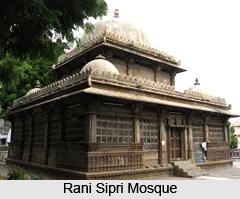 Rani Sipri Mosque, one of the oldest mosques in Ahmedabad, is an elegantly erected monument situated in the south-eastern part of the walled city in Gujarat. Formerly known as Rani Asni"s Mosque, it is a medieval mosque commissioned in 1514 by Rani Sipri, the Hindu wife of Mahmud Begada, a Sultan who ruled Gujarat.
Rani Sipri Mosque, one of the oldest mosques in Ahmedabad, is an elegantly erected monument situated in the south-eastern part of the walled city in Gujarat. Formerly known as Rani Asni"s Mosque, it is a medieval mosque commissioned in 1514 by Rani Sipri, the Hindu wife of Mahmud Begada, a Sultan who ruled Gujarat.
Construction of Rani Sipri Mosque
Rani Sipri Mosque is named after the Hindu queen of Sultan Mahmud Begada of Gujarat, Rani Sipri. The mosque is, thus, also a standing embodiment of the inter-religion marriages in those times that were prevalent among the Indian royalty. She commissioned the mosque in the year 1514 AD, when her husband executed their son for some misdemeanour. After her death, the queen was buried in the mosque.
Architecture and Interior of Rani Sipri Mosque
Rani Sipri Mosque is also known as the Masjid-e-Nagina, meaning jewel of a mosque, given its elegant and graceful design which reflects a blend of Hindu and Islamic architectural styles. Despite being a small structure stretching 50 feet high, 20 feet broad and 54 feet long, it attracts the attention of the tourists towards its elegantly proportioned symmetry, along with splendid and diaphanous minarets. Like other historical monuments of 16th century, this too is covered with splendid curvatures and distinguished filigree work. The interior of the domed mosque consists of intricately carved decoration. The `jali` screens inside have wonderful decorations of flowing plants and trees. The mosque provides ample space for its worshippers. There is also a separate place of worship upstairs for the "Jenana", the women folk. The overall elegant design of the religious edifice is adorable, making Rani Sipri Mosque one of the gems of Gujarati architecture and one of the most beautiful and appealing attractions of Ahmedabad.
This article is a stub. You can enrich by adding more information to it. Send your Write Up to content@indianetzone.com
Related Articles:
Monuments in Ahmedabad, Monuments of Gujarat
Indian Historical Monuments
Ahmedabad
Medieval History of Gujarat
History of Ahmedabad
Mosques in India
Hindu Architecture
Islamic Architecture



















